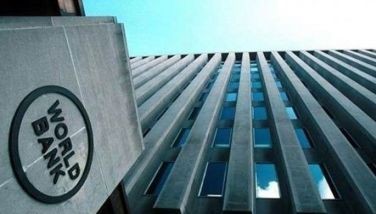Consumers turn upbeat on prospects for next year
September 12, 2005 | 12:00am
Consumers are turning more optimistic on the country’s economic prospects next year, coming off a highly negative outlook in the last two quarters of 2005, a central bank survey showed.
Based on the latest quarterly Consumer Expectation Survey by the Bangko Sentral ng Pilipinas (BSP), the overall diffusion index (DI) on consumer optimism in 2006 improved to -21.4 percent from -28.4 percent in the previous poll.
The DI is computed as the percentage share of respondents who answered in the affirmative less the percentage share of respondents who answered otherwise. Thus, a positive DI indicates a favorable view while a negative DI connotes a pessimistic outlook.
There are three component indices of the average DI: Philippine economic condition, family financial situation, and family income.
The BSP said the respondents’ outlook on the economic condition of the country and on family financial situation improved to —39.3 percent and —25.1 percent, respectively. Family income registered a positive DI of 0.3 percent from -4.7 percent in the previous survey.
The respondents said the better outlook was based on expectations of additional income, more jobs, sound government policies, and overseas jobs.
The BSP noted, however, that consumers’ optimism further declined in the third quarter of 2005 from an average DI of -49.9 percent to —54.1 percent, the lowest since the BSP initiated the survey in the third quarter of 2004.
The overall consumer outlook for the fourth quarter of 2005 also went down to —27 percent from —24.3 percent in the previous survey even as the family income index increased by 0.5 percentage point to —6.6 percent.
According to BSP, the respondents cited high prices of food, utilities, oil and transportation; insufficient income; and higher household expenditures as major factors for the decline in their outlook for the period.
Consistent with the improving consumer outlook for 2006, average family income is expected to rise as respondents estimated an average income improvement of 2.4 percent, the BSP said.
However, respondents expected a decrease in their family income for the third quarter of 2005 by an average of 7.4 percent compared to the 8.2 percent drop in their family income a year ago.
For the fourth quarter of 2005, respondents expected family income to decline by an average of 1.6 percent, a slight improvement from the previous quarter’s drop of 1.9 percent.
Despite an anticipated decline in family income, respondents expect their family’s expenditures on basic commodities to rise by an average of 4.6 percent in the fourth quarter of 2005. Basic items such as food, electricity and fuel, house rent and transportation were cited as the major components likely to drive up family expenditures. Respondents are also expected to adjust other expenses to maintain the family budget.
The BSP said consumers’ outlook on buying conditions for assets improved modestly in the third quarter of 2005 compared to the previous survey. Buying conditions indices for consumer durables and house and/or lot increased but declined in the case of motor vehicles.
The respondents also expected unemployment and interest rates to increase and the peso to depreciate in the next 12 months.
Meanwhile, inflation for the next 12 months is expected to slow down although households anticipate highest price increases in utilities, transportation, fuel and food.
Among the 2,193 survey respondents, 213 households or 9.7 percent have at least one overseas Filipino worker (OFW) in their household. About 88.3 percent of OFWs remitted money to their families during the last 12 months.
The survey likewise showed that OFW remittances were either spent on food and other household needs, appliances and children’s education, or invested in savings banks, cooperatives and other depository institutions.
A small percentage of respondents used OFW remittances for debt payments, investment in business/stocks, medicine, motor vehicle and house and/or lot purchase.
Based on the latest quarterly Consumer Expectation Survey by the Bangko Sentral ng Pilipinas (BSP), the overall diffusion index (DI) on consumer optimism in 2006 improved to -21.4 percent from -28.4 percent in the previous poll.
The DI is computed as the percentage share of respondents who answered in the affirmative less the percentage share of respondents who answered otherwise. Thus, a positive DI indicates a favorable view while a negative DI connotes a pessimistic outlook.
There are three component indices of the average DI: Philippine economic condition, family financial situation, and family income.
The BSP said the respondents’ outlook on the economic condition of the country and on family financial situation improved to —39.3 percent and —25.1 percent, respectively. Family income registered a positive DI of 0.3 percent from -4.7 percent in the previous survey.
The respondents said the better outlook was based on expectations of additional income, more jobs, sound government policies, and overseas jobs.
The BSP noted, however, that consumers’ optimism further declined in the third quarter of 2005 from an average DI of -49.9 percent to —54.1 percent, the lowest since the BSP initiated the survey in the third quarter of 2004.
The overall consumer outlook for the fourth quarter of 2005 also went down to —27 percent from —24.3 percent in the previous survey even as the family income index increased by 0.5 percentage point to —6.6 percent.
According to BSP, the respondents cited high prices of food, utilities, oil and transportation; insufficient income; and higher household expenditures as major factors for the decline in their outlook for the period.
Consistent with the improving consumer outlook for 2006, average family income is expected to rise as respondents estimated an average income improvement of 2.4 percent, the BSP said.
However, respondents expected a decrease in their family income for the third quarter of 2005 by an average of 7.4 percent compared to the 8.2 percent drop in their family income a year ago.
For the fourth quarter of 2005, respondents expected family income to decline by an average of 1.6 percent, a slight improvement from the previous quarter’s drop of 1.9 percent.
Despite an anticipated decline in family income, respondents expect their family’s expenditures on basic commodities to rise by an average of 4.6 percent in the fourth quarter of 2005. Basic items such as food, electricity and fuel, house rent and transportation were cited as the major components likely to drive up family expenditures. Respondents are also expected to adjust other expenses to maintain the family budget.
The BSP said consumers’ outlook on buying conditions for assets improved modestly in the third quarter of 2005 compared to the previous survey. Buying conditions indices for consumer durables and house and/or lot increased but declined in the case of motor vehicles.
The respondents also expected unemployment and interest rates to increase and the peso to depreciate in the next 12 months.
Meanwhile, inflation for the next 12 months is expected to slow down although households anticipate highest price increases in utilities, transportation, fuel and food.
Among the 2,193 survey respondents, 213 households or 9.7 percent have at least one overseas Filipino worker (OFW) in their household. About 88.3 percent of OFWs remitted money to their families during the last 12 months.
The survey likewise showed that OFW remittances were either spent on food and other household needs, appliances and children’s education, or invested in savings banks, cooperatives and other depository institutions.
A small percentage of respondents used OFW remittances for debt payments, investment in business/stocks, medicine, motor vehicle and house and/or lot purchase.
BrandSpace Articles
<
>
- Latest
- Trending
Trending
Latest























